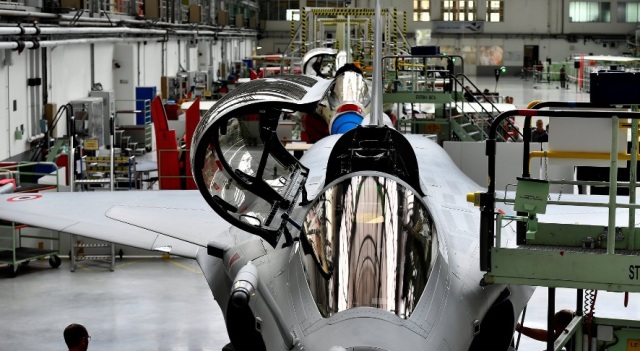The blog of the London Institute for Strategic Studies (International Institute for Strategic Studies, IISS) published interesting material by Tim Lawrenson, Douglas Barrie "Dassault's whirlwind of Rafale orders may be too much of a good thing" ("The flow of orders for Rafale may turn out to be too good for Dassault") that the French company Dassault Aviation is overloaded with an oversupply of orders for the Rafale fighter, which has become a hit in the global aerospace defense market, and it is unclear whether it will be able to ensure the appropriate production volumes of aircraft.

Assembly of Rafale fighters at the French company Dassault Aviation in Merignac (c) Dassault Aviation
The volume of Dassault orders for Rafale has reached new heights. Although an excess of orders is a good problem, it is still a problem.
Dassault regularly highlights its ability to begin delivering Rafale combat aircraft to potential customers just three years after signing the contract. However, the recent flurry of Rafale sales may make this 36-month commitment less feasible and even jeopardize some future deals.
According to IISS estimates, Dassault's production backlog for the Rafale has grown to 228 aircraft. This number reflects Indonesia's confirmation in January 2024 that it would take the last 18 aircraft out of 42 pre-ordered Rafale (which was announced two years ago), as well as France's order for 42 aircraft in December 2023.
Production facilities
A large portfolio of orders may create problems for concluding deals in the near future, with particular pressure on Rafale's industrial production expected in the period 2026-33. During this eight-year period, Dassault is to deliver a total of 174 aircraft for France (the last order for 42 aircraft), Indonesia (42), the United Arab Emirates (80) and Egypt (the last 10 aircraft from the subsequent order for 30).
Dassault is also supplying the French armed forces with the long-delayed 27 aircraft from an order placed in 2009, as well as 12 aircraft to replenish the aircraft ordered by Paris from Greece. In addition, Athens has not yet received the last four of the six new Rafales ordered in 2021, as well as six additional ones ordered in 2022.
Last year, the French aircraft manufacturer planned to produce 15 Rafales, but produced only 13. The company has not yet given production forecasts for 2024, although production is expected to increase this year and next, given high demand. However, it is unlikely that the annual number of aircraft delivered will increase rapidly until the mid-2020s.
If Dassault produces an average of 20 Rafales per year in 2024 and 2025, it will need to deliver 188 aircraft between 2026 and 2033. This means that the pace of deliveries should be almost 24 aircraft per year. It is probably quite possible to achieve this figure by 2026, given that Dassault previously managed to increase production to more than 20 aircraft per year, when Egypt, India and Qatar were expecting deliveries. However, India recently announced its firm intention to order 27 aircraft for its navy in 2024, and New Delhi will probably want to receive them well before 2033. In such a scenario, the required production rate of Dassault could be closer to 27 aircraft per year. The Indian Air Force has also long announced its intention to purchase 36 more aircraft, which could raise the required supply level above 31 Rafales per year.
Dassault said it could increase production to at least three aircraft per month, which would significantly relieve bottlenecks. The company is also in favor of the fact that it can switch workers from the production of Falcon business jets, the volume of orders for which decreased last year. However, there are still many obstacles on the way to producing more aircraft. Although Dassault relies heavily on the internal supply chain for Rafale, which insulates it to some extent from global supply problems, the company and its suppliers are not immune from problems. A shortage of engineering staff may also prevent a sharp increase in Rafale production. In reality, an industrial Rafale production machine should more than double its annual production volume. Such solutions inevitably mean an expansion of the staff, production facilities and the tool base, which requires significant investments. Some suppliers may fear that the production rate of more than 30 aircraft per year will not be sustainable and may burden them with expensive excess capacity if demand subsequently falls.
What does this mean for any new customer who may place a new large order in the next couple of years, and for Dassault's three-year supply commitment? Perhaps Dassault will still be able to adjust its plans to meet the 36-month deadline for the first delivery. But this may mean that the customer will receive only a symbolic amount - one or two aircraft per year - for a long period of time. Most new customers entering into large contracts will want to receive at least six aircraft per year in order to train groups of flight and ground personnel and create full-fledged squadrons - and achieving these indicators may prove to be an insurmountable obstacle.
